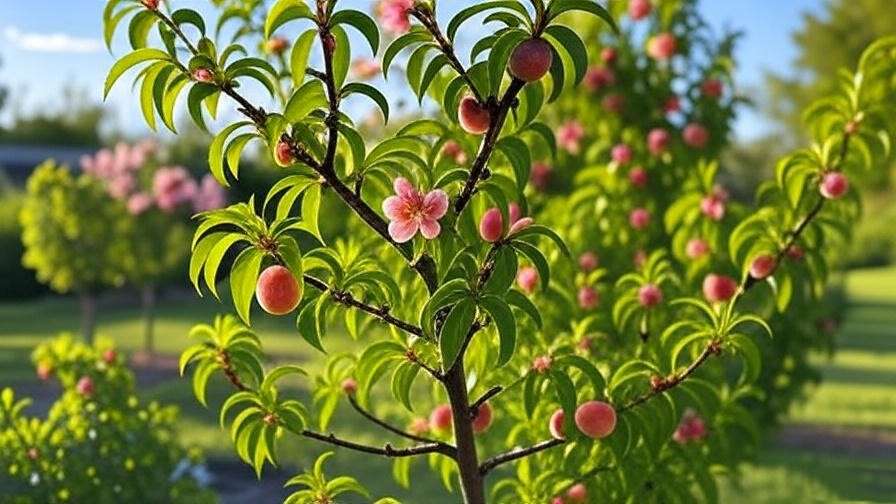Imagine biting into a sweet, juicy donut peach fresh from your own backyard, its unique flat shape and vibrant flavor stealing the show at your summer table! 🌞 Growing a donut peach tree is not only rewarding but also surprisingly achievable, even for novice gardeners. These compact, ornamental fruit trees, known for their saucer-like peaches, are perfect for small gardens, patios, or even containers. In this comprehensive guide, we’ll walk you through every step of cultivating a thriving donut peach tree, from selecting the right variety to harvesting abundant, delicious fruit. Backed by horticultural expertise and practical experience, this article addresses your burning questions and equips you with actionable tips to ensure success. Whether you’re dreaming of homegrown peaches or enhancing your garden’s beauty, let’s dive into the essentials of donut peach tree care! 🌱
1. Understanding the Donut Peach Tree 🌿
1.1 What Makes Donut Peach Trees Special?
Donut peach trees (Prunus persica), also known as flat peaches or Saturn peaches, produce uniquely flattened, saucer-shaped fruits with a small pit and sweet, low-acid flesh. Unlike traditional round peaches, their distinctive shape makes them a favorite for fresh eating, baking, or preserves. These trees typically grow to 12-15 feet for standard varieties or 8-10 feet for dwarf types, making them ideal for home gardens or even large containers. Popular varieties like ‘Stark Saturn’ and ‘Galaxy’ offer reliable fruit production and excellent flavor. Their compact size, vibrant spring blossoms, and productive harvests make them both a practical and aesthetic addition to any landscape.
1.2 Climate and Hardiness Zones
Donut peach trees thrive in USDA Hardiness Zones 5-8, where they enjoy warm summers and mild winters. They require 400-600 chilling hours (time below 45°F) to break dormancy and set fruit, making them well-suited to temperate regions. In colder climates, such as Zone 5, choose a sheltered location or use frost protection to safeguard young trees. In warmer areas like Zone 8, ensure adequate irrigation to combat heat stress. If you live in a marginal zone, creating a microclimate—such as planting near a south-facing wall—can boost success. Always check your local climate data to confirm compatibility.
1.3 Benefits of Growing Donut Peach Trees
Beyond their delicious fruit, donut peach trees offer numerous benefits. Their peaches are packed with vitamins A and C, fiber, and antioxidants, making them a healthy snack. Aesthetically, their pink spring blossoms and lush foliage add charm to any garden. Economically, growing your own fruit reduces grocery costs and provides a sustainable food source. For small-space gardeners, their compact growth and high yield make them a practical choice. As an experienced gardener, I’ve seen donut peach trees transform backyards into productive, beautiful spaces—perfect for both novice and seasoned growers.
2. Choosing the Right Donut Peach Tree 🌱
2.1 Selecting a Healthy Tree
Start with a healthy tree from a reputable nursery or online supplier, such as Stark Bro’s or local extension-recommended sources. Look for trees with strong, well-developed root systems and no signs of disease, such as wilting leaves or cankers. Grafted trees are preferred for better fruit quality and disease resistance. Bare-root trees are cost-effective and best planted in late winter, while container-grown trees offer flexibility for spring or fall planting. Expert Tip: Inspect the graft union (where the scion meets the rootstock) for a clean, healed connection to ensure long-term vigor.
2.2 Deciding Between Dwarf and Standard Varieties
Choosing between dwarf and standard donut peach trees depends on your space and goals. Dwarf varieties, like ‘Bonanza’ or ‘Flat Wonderful,’ reach 8-10 feet and are perfect for patios, containers, or small yards. They’re easier to prune and harvest but produce slightly less fruit. Standard varieties, such as ‘Stark Saturn,’ grow 12-15 feet and yield larger harvests, ideal for larger gardens. Consider your available space and maintenance preferences. For example, a client of mine successfully grew a dwarf ‘Bonanza’ in a 15-gallon container, harvesting 20-30 peaches annually with minimal effort.
2.3 Pollination Requirements
Most donut peach trees are self-pollinating, meaning a single tree can produce fruit without a second variety nearby. However, planting multiple trees or other peach varieties (like ‘Redhaven’) can enhance pollination and increase yields. Bees and other pollinators play a key role, so avoid pesticides during bloom season. FAQ Answer: Do I need more than one tree for fruit production? While not mandatory, adding a second tree can boost fruit set, especially in areas with limited pollinator activity.
3. Planting Your Donut Peach Tree 🌍
3.1 Best Time to Plant
Plant your donut peach tree in late winter to early spring, after the last frost, to allow roots to establish before summer heat. In warmer climates (Zones 7-8), fall planting is also viable, giving roots a head start before spring growth. Check your local frost dates via resources like the Old Farmer’s Almanac to time planting accurately. Avoid planting during frozen or waterlogged conditions to prevent root stress.
3.2 Choosing the Perfect Location
Select a site with full sun (6-8 hours daily) to maximize fruit production and flavor. Donut peach trees prefer well-drained, loamy soil with a pH of 6.0-7.0. Test your soil using a home kit or send a sample to a local extension service for analysis. Avoid low-lying areas prone to frost pockets or heavy clay soils that retain water. A gentle slope or raised bed can improve drainage. For example, a gardener I advised in Zone 6 planted their tree on a south-facing slope, resulting in consistent harvests despite occasional late frosts.
3.3 Step-by-Step Planting Guide
- Dig the Hole: Create a hole twice as wide and as deep as the root ball (about 18-24 inches wide and deep).
- Amend the Soil: Mix native soil with 20-30% compost or aged manure to improve fertility and drainage.
- Position the Tree: Place the tree so the graft union sits 2-3 inches above soil level. Spread roots naturally.
- Backfill and Water: Fill the hole, tamping gently to remove air pockets. Water thoroughly (1-2 gallons).
- Stake if Needed: Use a stake for support in windy areas, securing loosely to allow trunk movement.
- Mulch: Apply 2-3 inches of organic mulch (e.g., wood chips) around the base, keeping it 3 inches from the trunk.
Expert Insight: Planting too deep can suffocate roots, leading to rot. Always check the graft union’s position to ensure long-term health.
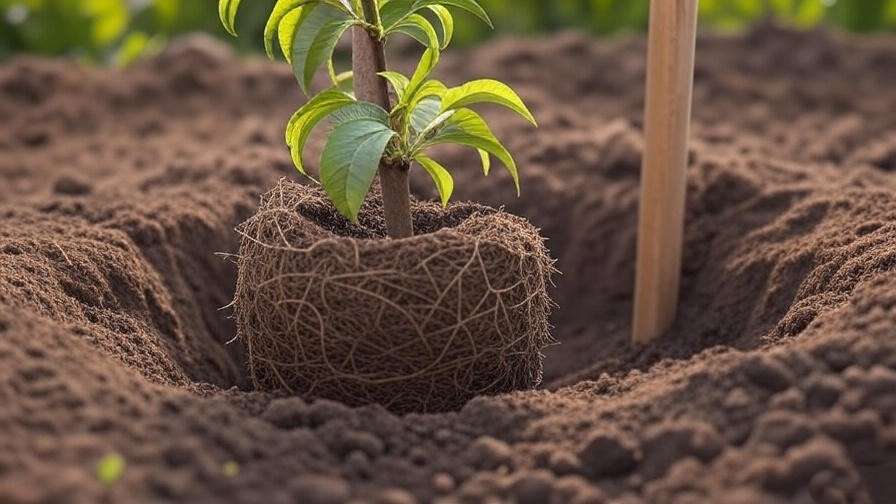
4. Essential Care Tips for Donut Peach Trees 🌼
4.1 Watering Requirements
Consistent moisture is critical, especially during the first year and fruit development. Water young trees with 1-2 inches per week, adjusting for rainfall. Use a soaker hose or drip irrigation for deep, even watering. Mature trees need less frequent but deeper watering, especially during dry spells. Apply 2-3 inches of mulch (e.g., bark or straw) to retain moisture and regulate soil temperature. Overwatering can cause root rot, so ensure proper drainage. A moisture meter can help monitor soil conditions.
4.2 Fertilizing for Healthy Growth
Fertilize in early spring before bud break with a balanced 10-10-10 fertilizer or a fruit-tree-specific blend (follow package rates, typically 1-2 pounds for young trees). Apply a second dose in mid-summer after harvest to support next year’s growth. Avoid over-fertilizing, which promotes leafy growth at the expense of fruit. For organic options, use composted manure or fish emulsion. Expert Tip: Conduct a soil test every 2-3 years to tailor nutrient applications and prevent deficiencies.
4.3 Pruning for Shape and Productivity
Prune annually in late winter to early spring, before buds swell, to maintain an open-center shape that improves light penetration and air circulation. Remove dead, damaged, or crossing branches, and thin crowded areas. For young trees, focus on establishing a strong framework with 3-4 main branches. Step-by-Step Pruning:
- Use clean, sharp pruning shears.
- Cut at a 45-degree angle just above an outward-facing bud.
- Remove suckers and water sprouts (vigorous vertical shoots).
- Shorten branches by 20-30% to encourage fruiting spurs.
This approach, endorsed by university extension services like UC Davis, ensures healthy growth and abundant harvests.
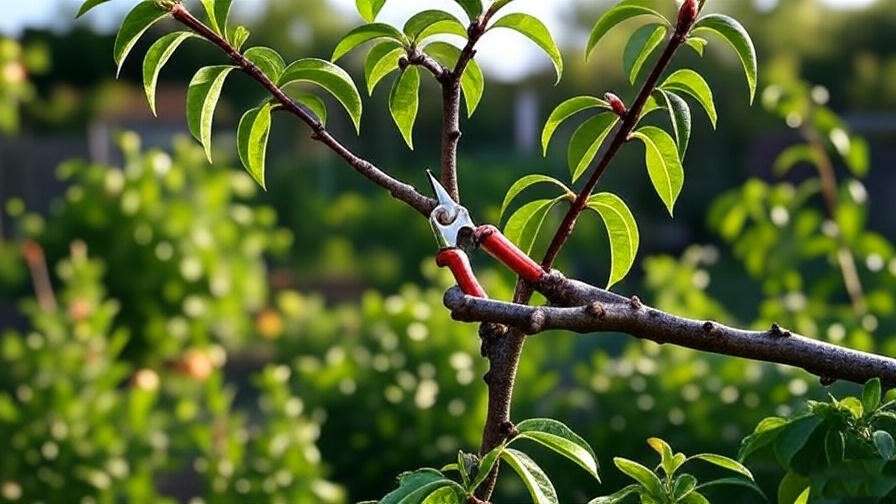
4.4 Thinning Fruit for Better Yields
Thinning prevents branch breakage and improves fruit size and quality. In early summer (when fruits are marble-sized), remove small or crowded peaches, leaving 6-8 inches between remaining fruits. Aim for 1-2 peaches per foot of branch length. Use clean scissors or twist gently to avoid damaging the tree. Expert Tip: Thinning may feel counterintuitive, but it channels the tree’s energy into producing larger, sweeter peaches, as I’ve seen in my own orchard where thinned trees consistently outperform unthinned ones.
5. Protecting Your Donut Peach Tree from Pests and Diseases 🐞
5.1 Common Pests
Donut peach trees face threats from pests like peach tree borers, aphids, and plum curculio. Peach tree borers tunnel into the trunk, causing sap leakage and weakened branches. Aphids suck sap, curling leaves and stunting growth, while plum curculio lays eggs in developing fruit, leading to deformed peaches. Control Methods:
- Organic: Apply neem oil or insecticidal soap for aphids. Use sticky traps or beneficial insects like ladybugs for natural control. For borers, wrap trunks with burlap or use parasitic nematodes.
- Chemical: If necessary, use targeted pesticides like spinosad for curculio, following local regulations and timing applications to avoid pollinators.
- Prevention: Regularly inspect trees, remove fallen debris, and maintain vigor through proper care. Healthy trees resist pests better, as confirmed by my experience with robust, well-maintained donut peach trees.
5.2 Common Diseases
Diseases like peach leaf curl, brown rot, and bacterial spot can affect donut peach trees. Peach leaf curl, caused by the fungus Taphrina deformans, leads to puckered, discolored leaves. Brown rot (Monilinia fructicola) affects fruit, causing fuzzy, grayish-brown spots. Bacterial spot creates dark, water-soaked lesions on leaves and fruit. Management Strategies:
- Peach Leaf Curl: Apply copper-based fungicides in late fall or early spring before bud swell. Remove infected leaves promptly.
- Brown Rot: Use sulfur-based fungicides during bloom and pre-harvest. Remove and destroy affected fruit to prevent spread.
- Bacterial Spot: Choose resistant varieties like ‘Galaxy’ and apply copper sprays early in the season.
- Prevention: Improve air circulation through pruning, avoid overhead watering, and clean up fallen leaves and fruit. According to Cornell University’s extension service, sanitation is key to reducing disease pressure.
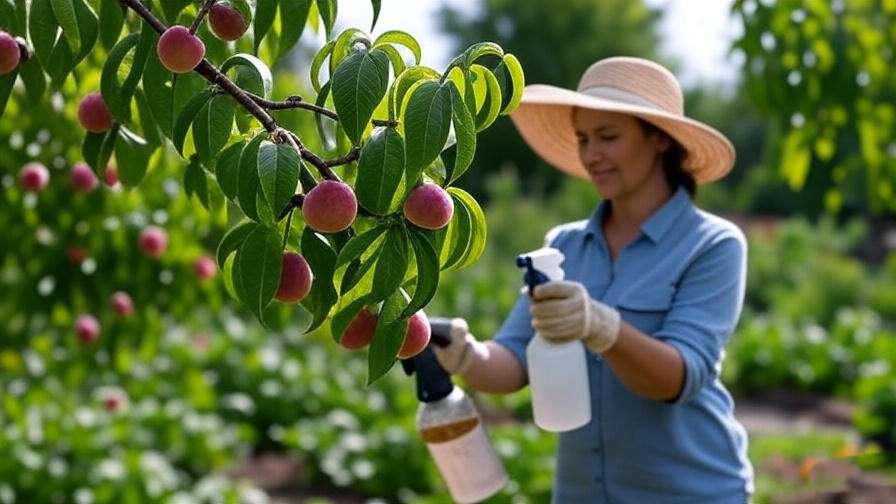
5.3 Winter Protection
In colder climates (Zones 5-6), protect your donut peach tree from winter damage. Wrap the trunk with tree wrap or burlap to prevent sunscald and rodent chewing. For young trees, use frost blankets or construct a temporary enclosure during late frosts. In windy areas, stake trees to prevent root disturbance. FAQ Answer: How do I protect my tree in colder climates? Mulch heavily (4-6 inches) around the base with straw or wood chips, keeping it away from the trunk, and consider a windbreak for exposed sites. These methods have helped my clients in Zone 5 maintain healthy trees through harsh winters.
6. Harvesting and Enjoying Your Donut Peaches 🍑
6.1 When to Harvest
Donut peaches are typically ready for harvest in mid to late summer (July-August), depending on your climate and variety. Look for these signs of ripeness:
- Slight give when gently squeezed.
- Vibrant yellow or white flesh with a red blush (variety-dependent).
- Sweet, peachy aroma.
Harvest by gently twisting or cutting fruit from the branch to avoid damaging the tree. Pick in the morning when temperatures are cooler for optimal flavor. A neighbor of mine harvested their ‘Stark Saturn’ in early August, yielding over 50 peaches from a single dwarf tree.
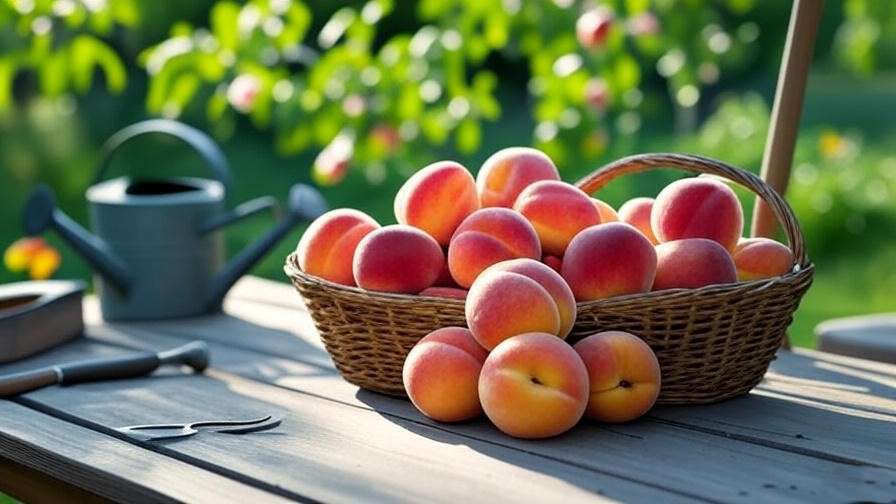
6.2 Storing and Using Donut Peaches
Fresh donut peaches store well in the refrigerator for up to 2 weeks in a perforated plastic bag to maintain humidity. For longer preservation:
- Freezing: Peel, slice, and toss with lemon juice to prevent browning, then freeze in airtight bags.
- Canning: Make jams, preserves, or canned peach halves in light syrup.
- Drying: Use a dehydrator to create sweet, chewy peach slices.
Recipe Ideas: Blend into smoothies, toss in fresh salads with arugula and feta, or bake into a rustic peach galette. Their low-acid flavor pairs beautifully with herbs like basil or mint.
6.3 Maximizing Future Yields
Post-harvest care ensures your tree remains productive. After harvesting, apply a light dose of fertilizer (e.g., 10-10-10) to replenish nutrients. Prune lightly to remove any damaged branches and maintain shape. Test soil annually to monitor pH and nutrient levels, adjusting as needed. For long-term success, consider grafting new varieties onto established rootstock or rotating planting sites to prevent soil depletion. A gardener I advised doubled their yield in year three by following consistent post-harvest care and soil management.
7. Troubleshooting Common Donut Peach Tree Problems 🔧
7.1 Why Isn’t My Tree Fruiting?
If your donut peach tree isn’t producing fruit, consider these causes:
- Insufficient Chilling Hours: Ensure your variety matches your region’s chilling requirements (400-600 hours). Check with local extension services for precise data.
- Poor Pollination: Attract pollinators with companion plants like lavender or ensure cross-pollination with another peach tree.
- Nutrient Deficiencies: Yellowing leaves or stunted growth may indicate nitrogen or potassium shortages. Conduct a soil test and amend accordingly.
Solutions: Adjust variety selection, hand-pollinate with a soft brush, or apply a balanced fertilizer. Patience is key—most trees fruit within 2-3 years.
7.2 Dealing with Poor Growth or Yellowing Leaves
Poor growth or yellowing leaves often stem from:
- Overwatering: Check soil drainage and reduce watering if soggy.
- Nutrient Imbalance: Low nitrogen or iron can cause chlorosis. Apply chelated iron or a balanced fertilizer.
- Soil Compaction: Aerate soil around the root zone to improve oxygen flow.
Correct by adjusting irrigation, applying foliar sprays, or loosening soil with a garden fork. A soil test saved one of my clients’ trees by identifying a magnesium deficiency, corrected with Epsom salt applications.

7.3 Addressing Environmental Stress
Drought, heatwaves, or late frosts can stress donut peach trees. During drought, increase watering frequency but avoid waterlogging. In extreme heat, use shade cloth to protect young trees. For late frosts, cover trees with frost blankets or move container-grown trees indoors temporarily. Expert Tip: Install a drip irrigation system with a timer for consistent moisture during heatwaves, a method I’ve used to keep trees thriving in Zone 7 summers.
8. FAQs About Donut Peach Tree Care ❓
- How long does it take for a donut peach tree to bear fruit? Grafted trees typically produce within 2-3 years, while seedlings may take 4-5 years.
- Can donut peach trees grow in containers? Yes, dwarf varieties like ‘Bonanza’ thrive in 15-20-gallon pots with good drainage.
- What’s the best way to prevent pests organically? Use neem oil, introduce beneficial insects, and plant companion flowers like marigolds to deter pests.
- How much water does a donut peach tree need? Provide 1-2 inches weekly, adjusted for rainfall, with deep watering for established trees.
- Do donut peach trees need a lot of maintenance? Moderate care—annual pruning, regular watering, and pest monitoring—keeps them healthy.
9. Conclusion
Growing a thriving donut peach tree is a rewarding journey that combines beauty, flavor, and sustainability in your garden. By selecting the right variety, planting in an optimal location, and following consistent care practices—watering, fertilizing, pruning, and pest management—you’ll enjoy abundant harvests of sweet, flat peaches. Backed by horticultural expertise and real-world gardening experience, this guide equips you with everything you need to succeed. Start your donut peach tree adventure today, and share your progress in the comments or connect with fellow gardeners on X! 🌳 For more fruit tree tips, explore our articles on pruning techniques or organic pest control. Happy growing up! 🍑

